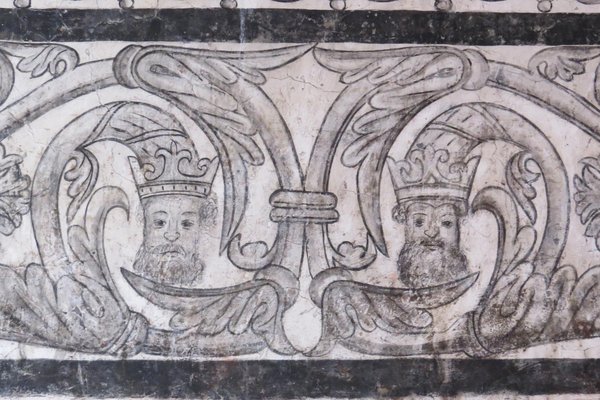Mexico
Popocatepetl monasteries
The Earliest 16th-Century Monasteries on the Slopes of Popocatepetl were instrumental to the evangelisation and colonisation of central and northern Mexico.
They were built by the first missionaries of the Franciscan, Dominican and Augustinian orders. They are characterized by their open spaces for worship. Their model was later used to expand to the north via “missions”.
Community Perspective: The ones in Tepotzlan (murals), Huejotzingo (fortified structure), Tlayacapan (huge with many chapels), Yecapixtla (Isabelline interior) and Atlatlahucan (vibrantly coloured murals) are recommended.
Site Info
Official Information
- Full Name
- Earliest 16th-Century Monasteries on the Slopes of Popocatepetl (ID: 702)
- Country
- Mexico
- Status
-
Inscribed 1994
Site history
History of Popocatepetl monasteries
- 2021: Extended
- To include Franciscan Ensemble of the Monastery and Cathedral of Our Lady of the Assumption of Tlaxcala
- 1994: Revision
- Has been on T List since 1986 as "16th C Convents in State of Morelos"
- 1994: Inscribed
- Inscribed
- Type
- Cultural
- Criteria
- ii
- iv
Links
- UNESCO
- whc.unesco.org
- Official
-
- cultura.gob.mx — Ruta de los Monasterios
All Links
UNESCO.org
- whc.unesco.org — whc.unesco.org/
Official Website
- cultura.gob.mx — Ruta de los Monasterios
Community Information
- Community Category
- Religious structure: Christian
Travel Information
Mexico City hotspot
Recent Connections
-
Perfect Inscriptions
1994 -
Christian missions
"in the form of a large number of small… -
Upstream process
For the extension (in upstream process …
Connections of Popocatepetl monasteries
- Individual People
-
-
Hernán Cortés
Cuernavaca Cathedral: Building of the complex proper began in 1529 on land donated by Juana de Zúñiga de Cortés, Hernán Cortés’s wife (wiki)
-
- Trivia
-
-
Cultural sites closely connected to volcanoes
Popocatepetl volcano
-
- Architecture
-
-
Mudejar style
Tlaxcala: "The main nave of the church has one of the few examples of Moorish art in the Americas." (wiki)
-
- Damaged
-
-
Destroyed or damaged by Earthquake
Each one of the 14 sites was affected and had to be closed, after the September 19, 2017 earthquake. The temples of Tlacayapán and Totolapán seem to have been the most affected.
-
- World Heritage Process
-
-
Upstream process
For the extension (in upstream process since 2019) -
Perfect Inscriptions
1994 -
Extended
2021: To include Franciscan Ensemble of the Monastery and Cathedral of Our Lady of the Assumption of Tlaxcala
-
- Religion and Belief
-
-
Cathedrals
Cath of the assumption of Mary -
Franciscan Order
-
Augustinian Order
Ocuituco, and several others -
Fortified religious buildings
"These monasteries were built very solid with thick walls and very austere. In some of the complexes, one can see stone merlons which make the complexes look like castles or forts. These were for defensive purposes as the monks were invading Mesoamerican lands to impose a new religion. For this reason, churches and monasteries of this type are called "fortress temples." (wiki) -
Dominican Order
-
Christian missions
"in the form of a large number of smaller establishments known as “missions” rather than monasteries" (OUV)
-
- WHS on Other Lists
-
-
Most beautiful villages
Tepoztlán is among Mexico's Pueblos Mágicos ("Magical Towns")
-
- Timeline
-
-
Built in the 16th century
See its full name
-
- WHS Hotspots
-
-
Mexico City hotspot
Several, including Cuernacava (1h by bus)
-
- Visiting conditions
- WHS Names
-
-
Named after a Mountain
Popocatepetl - 5,426 m
-
News
No news.
Recent Visitors
Visitors of Popocatepetl monasteries
- Alberto Rodriguez Gutierrez
- Alejandro Lau
- Alexander Barabanov
- Alexander Lehmann
- Alex Baranda
- Argo
- Artur Anuszewski
- Atila Ege
- Bill Maurmann
- Can SARICA
- Carlo Sarion
- Carlos Sotelo
- Caspar
- Cheryl
- Christine
- Clyde
- Daniela Hohmann
- Delphine Delaunay
- Dimitar Krastev
- Els Slots
- Erik Jelinek
- Eva Kisgyorgy
- Fan Yibo
- Fede1203
- Federico P.
- Feldhase
- Francky D'Hoop
- Frédéric M
- GeorgeIng61
- Gernot
- Hammeel
- Harald T.
- Iain Jackson
- Ian Cade
- Ivan Rucek
- Jacob Choi
- Jana and Matt
- janis
- Janos
- Jarek Pokrzywnicki
- Javier Coro
- Jawnbeary
- Jay T
- Jean Lecaillon
- Jens
- João Aender
- Joel on the Road
- Jon Opol
- Karito Vies
- Kasper
- kayakka
- Kbooth
- Ken DJ
- KngAlaric
- Krzysztof B
- Kurt Lauer
- Lara Adler
- lichia
- Lucas Del Puppo
- Lucio
- Ludvan
- Luis Filipe Gaspar
- Lukasz Palczewski
- Malgorzata Kopczynska
- Martina Rúčková
- Matthewsharris
- Michael Ayers
- Michael Novins
- michaelsballard
- Miguel Marquez
- Mihai Dascalu
- Mikko
- MMM
- Mstrebl1990
- nan
- Nihal Ege
- palka25
- Paul Schofield
- Philipp Peterer
- Pink Bunny
- Piotr Wasil
- puessergio
- Randi Thomsen
- Roger Ourset
- Roman Bruehwiler
- Sergio Arjona
- Shandos Cleaver
- shoaibmnagi
- Simonf
- Slavi
- sncjob
- Solivagant
- Stan
- Stanislaw Warwas
- Svein Elias
- Szucs Tamas
- Taotao Chen
- Thomas Buechler
- Thomas van der Walt
- Tim Allen
- triath
- ValiaVeweth
- Van Hung
- Velvetlapis
- Vernon Prieto
- Walter
- Wojciech Fedoruk
- Xiquinho Silva
- ZCTLife
- Zoë Sheng
- Zos M
- ZZSong
Community Reviews
Show full reviews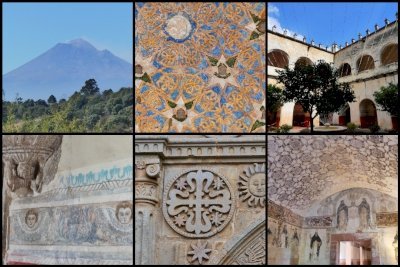
I visited this WHS in December 2021 focusing on three locations offering some of the best interior murals and exterior architectural details: namely Atlatlahucan, Tepotzlan and Cuernevaca.
Coming from Puebla, on the way we stopped to take some photos of the puffing Popocatepetl volcano since the three locations we chose were quite deep in the Popocatepetl valley far from the volcano proper. First we stopped at the sleepy town of Atlatlahucan to see the monastery of San Mateo Atlatahucan which was founded by Fray Jorge de Avila of the Order of the Augustinians in the 16th century. Fray Jorge de Avila also founded the monasteries of Tlayacapan, Ocuituco, Yecapixtla and Totolapan, which are all part of this WHS.
The complex is rectangular. There is an open chapel in the northwest corner built with three arches. The facade of the church has an undecorated arched door; above that is a rectangular coral window set in a niche surrounded by small pilasters. Above it there is a classic clock dating from the latter part of the 19th century. To the rear of the church, there is a bell tower which appears to have been built later than the church, although it is in the same style. Around the monastery there is a tall wall with the characteristic crenellated walls of the Popocatepetl monasteries and the whole setting is now a tranquil garden or park. Like most monasteries and structures in the region, the Septemper 2017 earthquakes had a significant toll …
Keep reading 0 comments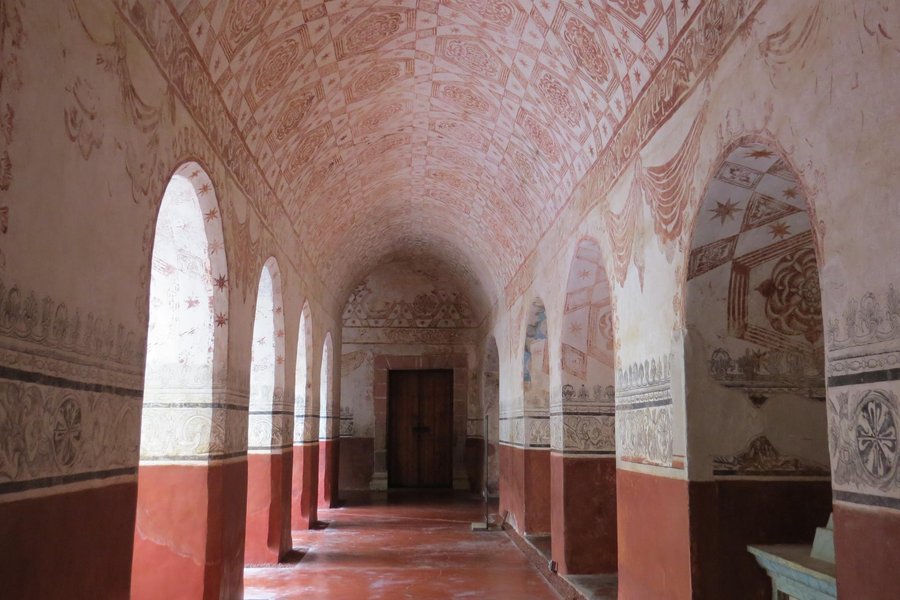
Time of visit: November 2021
Duration of visit: 2 hours
Mode of transportation: by rental car, day trip from Mexico City
Review and experience
Yet another review where I'm unlikely doing the actual WHS justice. Like several others who have reviewed this site, we only had the chance to visit the Cuernavaca Cathedral and the church in Tepoztlan. The significance of these sites is indisputable - nearly every cathedral and church we visited over the course of our 3 weeks' stay in central Mexico shared similar characteristics to these earliest churches of Mexico, as do some old missions in my home state of California. The large single nave, adjacent monastic buildings, and beautiful courtyard and the two-level convent filled with arches. As such, its OUV and its inscription on the basis of Criteria (ii) and (iv) felt sufficiently appropriate.
However, for the Cuernavaca Cathedral, its belltower was interesting and (potentially most) unique, as it resembled the Seville Cathedral's Giralda Tower. Of course, that tower was initially built as a mosque minaret, so it's interesting to see the Moorish influence brought over to the New World from this angle. That said, I don't think this particular component of the cathedral's broader style is as frequently replicated in other churches we had seen in Mexico. The height of the belltower is domineering to the nearby skyline, and it's a little sad that the recent earthquake damaged the cathedral, and I believe a part of the belltower collapsed.
… Keep reading 0 comments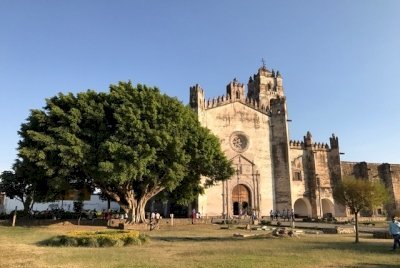
I visited this site around New Years 16/17 during a visit to friends in Cuernavaca. It is not an easy site to visit thoroughly since there are many monasteries and they are all slightly different but to the rushing beholder not very much. It takes an effort to appreciate the individuality of each site. In addition the monasteries are all rather bulky, they look more like fortresses then like churches and that was certainly intentional since missionary time could be dangerous and the local population might not always and everywhere be equally enthusiastic or just willing to adopt the new faith. For me it helps neither that the interior were often converted to baroque style, a fact that makes a visit to latin American churches (and sometimes in Spain and in eastern European countries) a real challenge.
Nonetheless the number of monasteries in a relatively small area and their age are very impressive. Many have impressive facades, others interesting cloisters. Some interiors are extremely plain, others have elaborate gothic constructions. All impress by their seize. The most remarkable feature are certainly the openair chapels and it is not completely clear to me if they were build to worship more in the way the locals were traditionally used to or if the monks didn't allow the locals to enter the sacred space of the church. Perhaps both. Looking back and comparing them makes appreciate almost better then and they seem more various and interesting then I remembered them. As a …
Keep reading 0 comments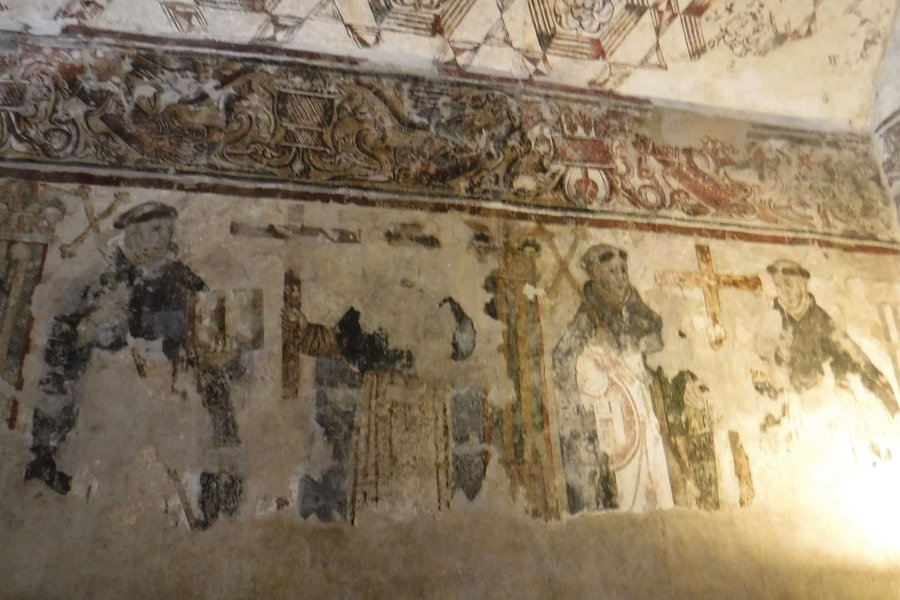
I am afraid that this review will bring very little new information, as I visited the same two monasteries as most of the previous reviewers, la Catedral de Cuernavaca and Tepoztlán Ex Convento Dominico de la Natividad. These two sites offered an interesting perspective on the beginnings of the evangelization of indigenous peoples in Mexico, but the September 2017 earthquake in the state of Puebla affected my appreciation of the sites. Indeed, although I visited the monasteries in March 2019, almost a year and a half after the earthquake, the damage had still not been repaired and the interior of the monasteries was inaccessible.
I first visited Tepoztlán, where the monastery is clearly visible from all over the city. Its size is imposing, its walls are high and bear merlons, which makes it look more like a military fort or a castle than a place of worship. This reflects the situation when religious congregations were involved in the invasion and domination of the Auochtone communities and had to protect themselves from them. Unfortunately, the earthquake seems to have been stronger than the monastery. In 2019, the two towers (one of which had visible cracks) were supported by wooden frameworks, a tin roof covered the monastery and the access to the convent was fenced off. Only a shop and a few rooms with faded frescoes were accessible from the left side of the building.
The situation was similar in Cuernavaca. El Recinto de la Catedral, although more ornate and artistically richer …
Keep reading 0 comments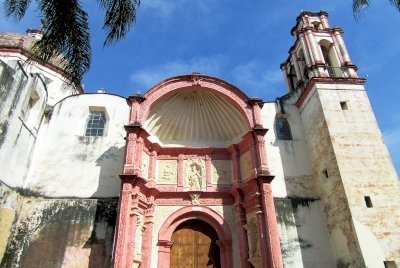
Volcanoes bring tremendous change to their environments, and fittingly the 16th-century monasteries established around the active volcano Popocatépetl, southeast of Mexico city, effected tremendous cultural change on the peoples of Mesoamerica. Here missionaries settled in concert with Spanish colonists, helping to establish the Catholic church as a dominant force in Mexican life.
I'm afraid I am not much more original than other visitors to this World Heritage Site, as I chose to visit the Cuernavaca Cathedral en route to Xochicalco, and hoped to visit the Convent of the Nativity in Tepoztlán before returning to Mexico City. I arrived early in the morning and was able to walk around the grounds of the cathedral complex before many other tourists arrived. The church was simply furnished, with walls decorated with murals, some of which depict Christianity coming to East Asia. The outdoor patio was beautifully landscaped, and the chapels around the church were brightly painted and well maintained. Cuernavaca is a fascinating city on its own, and unfortunately I spent too much time there before my visit to Xochicalco, so that I had no time left in the afternoon to visit Tepoztlán before an early January sunset. However, paired with my earlier visit to the Museum of the Viceroyalty of New Spain at Tepotzotlán, part of the Camino Real north of Mexico City, I felt like I had a better understanding at how the Catholic church began its evangelization of Mexico.
Logistics: The Cuernavaca Cathedral is a short walk from …
Keep reading 0 comments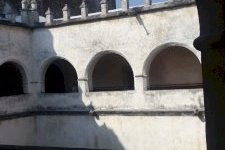
Similarly to Els and Ian I ended up visiting both Cuernavaca and Tepoztlán. I say ended up as my original plan was to only visit Cuernavaca. Cuernavaca has the benefit that you are passing through the town in any case when travelling from Mexico City to Xochicalco by bus. So it's really quite a simple and quick visit.
However, Cuernavaca is underwhelming as a site. Of the inscribed monasteries, Cuernavaca is the one which was redone and remodeled the most over the centuries. So much so that little original 16th century constructions remain. The oldest part is the open chapel, the Capilla abierta. And frankly I barely noticed it.
So after I had done my loop through Mexico on my last day in Mexico I traveled to Tepoztlán to fill the gap. Tepoztlán is the superior site with an actual monastery and pretty murals being preserved. I really enjoyed my visit and if you were to visit one of the two, I would go for Tepoztlán.
Getting There
Both Tepoztlán and Cuernavaca are connected by direct express bus from Mexico City. Cuernavaca has multiple bus terminal while the bus stop in Tepoztlán is on the main road on the outskirts of the town.
While You Are There
From Cuernavaca you can connect to Xochicalco by bus. Cuernavaca also boasts a nice old town, specifically the market square with the home of Cortes. Tepoztlán is a fairly sleepy town. The main attraction is the …
Keep reading 0 comments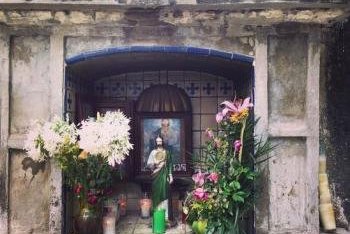
It was interesting to get to grips with why the monasteries look like they do, and it reveals a story about the early relationship between European and indigenous populations. We only managed to visit two sites but this felt sufficient to gain an understanding.
The monasteries are arranged around courtyards, it seems this illustrates European adaptation of indigenous religious practice which for the main congregations normally took place in the open air. It also meant that more people could attend masses. Whilst travelling around I listened to this episode of A history of the World in 100 objects, and whilst it doesn't directly relate to one of the listed sites it gave me a very good introduction to the concepts that make these places of outstanding universal value.
Not for the first time on our trip we ended up unknowingly following in Els footsteps. Our first stop was the Cathedral in Cuernavaca, which I found to be rather magnificent. The huge paintings on the internal walls were wonderful, and well complemented by the modern decorations and details inside.
Cuernavaca itself was also a worthwhile place to explore, especially the town hall in Cortes' former palace, with a balcony covered in magnificent Rivera murals telling the history of Mexico.
The only other monastery we visited was in Tepoztlán, buried in the heart of this interesting town the same courtyard layout could be seen. On entering the first thing that struck me was the familiar paintings that Els' photographed. I had …
Keep reading 0 comments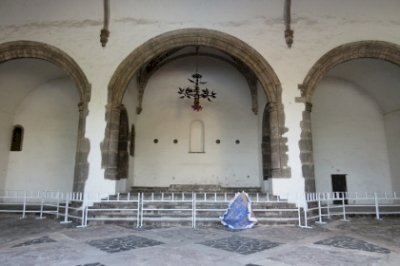
Out of the 14 designated locations that comprise this WHS, I visited the former monasteries of Cuernavaca and Tepoztlan. The one in Cuernavaca is attached to the Cathedral, but I had some trouble finding it. The cathedral lies within an enclosed area, with two pretty chapels at the corners and its own interior shouldn’t be missed either. The early 16th century remains were hidden behind a party tent, and consisted of nothing more than a simple altar and indeed an “open area” for the indigenous people to stand and listen. It’s attached to the main cathedral, which seems to be part of the WHS as well. This church is well worth a look, as it is a mixture of modern features with old wall paintings in the nave that is mentioned in the AB evaluation.
On my last day in Mexico, I went on a day trip by local bus from Cuernavaca to Tepoztlan. It’s a ride of only 45 minutes, but the town is situated much more nicely in the mountains. No views of the Popocatepetl though. The former monastery here is easier to find, as it is both a lot bigger and signposted. Entrance is free, and they’ve turned it into a museum annex exhibition space for local artists. Explanations are given via information panels in each room, but only in Spanish. The hallways of the monastery are completely covered with red and black murals which are very pretty. It also has characteristic crenelated walls. The open …
Keep reading 0 comments
I visisted 10 of the 14 monasteries from the 16 century in the slopes of the Popocatepetl in Morelos and here is waht I found:
a) San Mateo Apostol in Atlatlauhcan: Not so bas conservate, but it needs work
2) de la Natividad in Tepoztlán: Is one of the most well taken care off and in reconstruction
3) San Juan Bautista in Tetela del Volcán: It's conditions are the worst
4) San Juan Bautista in Tlayacapan: Very nice, but it still needs reconstruction
5) Santo Domingo de Guzmán in Hueyapan: This is in the worst state. I couldn't even enter because it was really early, for what I saw from the outside it has been painted in pastel colors!
6) San Guillermo in Totolapan: I almost cried when I saw it. The upper floor has been remodelated to serve as rooms for he priests so all the frescoes are lost.
7) Santo Domingo in Oaxtepec: Very nice
8) Santo Domingo in Yecapixtla: Taken care off, but it needs work
9) Santiago Apóstol in Ocuituco: Nice, but is not very cared
10)Inmaculada Concepción in Zacualpan de Amilpas: It needs more work, although is in very good state
Keep reading 0 comments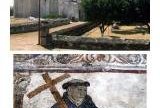
The description of this site’s 14 monasteries as being “on the slopes of Popocatapetl” demonstrates a considerable degree of poetic license! Only 4 could, by the wildest stretch of imagination, be said to be literally on that volcano’s “slopes” and many are quite a long distance away! Nevertheless the buildings have their interests as representing the very earliest stages of the “Christianisation” embarked upon by the Spaniards in the years immediately following the “Conquest” of Mexico in 1521. Only 2 years later the Franciscans established the first of these monasteries in Cuernavaca – the rest followed within the next 50 years. So most are large, fortified structures (photo 1) reflecting, in a number of ways, the times in which they were built.
The first problem for anyone wanting to visit is to establish EXACTLY which monasteries got inscribed!! The ICOMOS evaluation lists 14 (11 in Morelos and 3 in Puebla states – generally west and east of Popocatapetl respectively) but recommends that the entire nomination should be deferred and that the “states party” should be invited to “consider the omission of Hueyapan (and also Cuernavaca if assurances cannot be given that recent constructions will be removed)”. Today (March 2008) the UNESCO Web site states “These 14 monasteries……” but then only lists 13 – the original list less Hueyapan! A further complexity is that the ICOMOS evaluation clearly believes that it is including the monastery at Oaxtepec (an important site as it was the first monastery established by the Dominicans in …
Keep reading 0 comments
